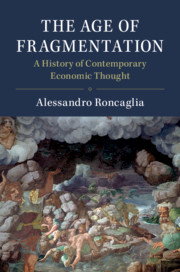Book contents
- The Age of Fragmentation
- The Age of Fragmentation
- Copyright page
- Contents
- Acknowledgements
- 1 Introduction: A Non-linear Discourse
- Part I The Background
- 2 The Foundations: Classicals and Marginalists
- 3 The Immediate Precursors
- Part II The Giants of the Short Century
- Part III The Disgregation of the Mainstream
- Part IV The Weakening of the Paradigm
- Part V Is a New Paradigm Possible?
- References
- Index
3 - The Immediate Precursors
from Part I - The Background
Published online by Cambridge University Press: 25 November 2019
- The Age of Fragmentation
- The Age of Fragmentation
- Copyright page
- Contents
- Acknowledgements
- 1 Introduction: A Non-linear Discourse
- Part I The Background
- 2 The Foundations: Classicals and Marginalists
- 3 The Immediate Precursors
- Part II The Giants of the Short Century
- Part III The Disgregation of the Mainstream
- Part IV The Weakening of the Paradigm
- Part V Is a New Paradigm Possible?
- References
- Index
Summary
In the framework of a critical illustration of the contemporary history of economics, this chapter provides a brief illustration of Wicksell and the Swedish school, Veblen and his institutionalism, Weber and his method, Schumpeter and his notions of statics and dynamics, Keynes and his views on probability and uncertainty as well as on finance and employment
- Type
- Chapter
- Information
- The Age of FragmentationA History of Contemporary Economic Thought, pp. 31 - 56Publisher: Cambridge University PressPrint publication year: 2019

